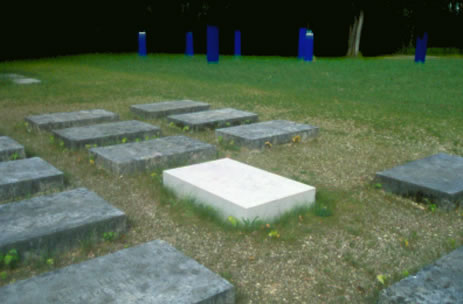
1998
Photo: Rolf Sturm
Monuments and memorials for the victims of National Socialism
[5] The debate about history is a laborious process which needs openness and inquisitiveness. The age of the simple answer is fortunately over. Today one is encouraged to think and contemplate. In the coding of some works of art the threads already exist to help one through the labyrinthine ways of insanity and realization that is if one wants to. The artistic way of portraying history is more subjective than the scientific documentary style. Pictures and impression are created that can stay longer in the mind. But non-the less they incorporate just one particle of the whole. If history is to come together, more effort is required.
The Israeli reclining stone is such a picture, which puzzle rather than give an answer. It is unnoticeable but that hides a key role that it plays in the complete ensemble. It is a link between the various periods but is also independent. It pose the difficult question of the integration and the rejection of the Jewish citizen through all the periods of our century, a theme that now even since the first world war cannot be contemplated without bringing in the later Holocaust. It shows how fragile the integration was when even patriotic Jewish soldiers had to suffer under anti-Semitism which forced them to consider their own identities. The stone do not just give its own critical commentary about the art and wise of the traditional military memorial but also remind us of the constant dangers that exist in our integrated daily lives.
Stefanie Endlich. Das dialogische Prinzip, Anmerkungen zum Entwurf von Dagmar Pachtner. In the memorial documentation 1999, Pg. 13